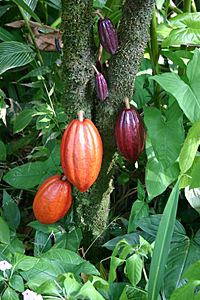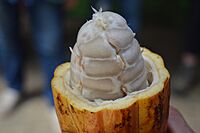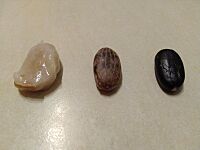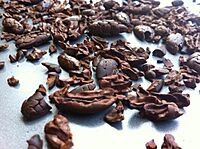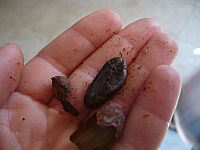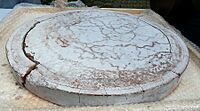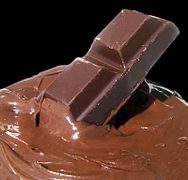Cocoa bean facts for kids
The cocoa bean is the dried and fermented seed of the Theobroma cacao tree, also known as the cacao tree. From these beans, we get cocoa solids (the non-fat parts) and cocoa butter (the fat). Cacao trees originally grew in the Amazon rainforest. Cocoa beans are the main ingredient for chocolate and traditional Mesoamerican foods like tejate, a special drink from Mexico.
People first started growing cacao trees over 5,300 years ago in South America by the Mayo-Chinchipe culture. Later, it was brought to Mesoamerica. Ancient cultures used cacao in special ceremonies, and its beans were even used as money. Today, most of the world's cocoa (about 81%) comes from West Africa. The most common types of cocoa plants are Forastero, Criollo, and Trinitario.
In 2024, the world produced about 5.8 million tonnes of cocoa beans. Ivory Coast was the biggest producer, making 38% of the total, followed by Ghana and Indonesia. Many groups around the world are working to make sure cocoa is grown in a way that is good for the planet and the people who farm it. This includes groups like the Swiss Platform for Sustainable Cocoa (SWISSCO) and Germany's Initiative on Sustainable Cocoa (GISCO). About 29% of all cocoa produced in 2016 met these voluntary sustainability standards. Growing cocoa can sometimes lead to deforestation, especially in West Africa. But new farming methods, like agroforestry, help grow cocoa while protecting nature. Cocoa is very important for the economies of countries like Nigeria, and people's love for cocoa products has been growing steadily since 2008.
Cocoa beans contain natural plant compounds called phytochemicals, like flavanols. These can have a small effect on lowering blood pressure. The beans also have theobromine and a little bit of caffeine. A cacao tree takes about five years to grow and can live for 100 years.
Contents
- Discovering the Cocoa Bean
- Images for kids
- See also
Discovering the Cocoa Bean
What's in a Name?
The word "cocoa" is a slightly changed version of "cacao." It might have come from an ancient word, kakaw(a), from either the Nahuatl or Mixe-Zoquean languages.
In the past, during the 18th century, people called cocoa beans "chocolate nuts" or "cocoa nuts." The term "cocoa beans" became popular in the 19th century.
Where Do Cocoa Beans Come From?
The cacao tree originally grew in the Amazon rainforest. People first started growing it about 5,300 years ago in what is now southeast Ecuador. This was done by the Mayo-Chinchipe culture. Later, it spread to Mesoamerica.
Ancient Uses of Cocoa
Over 3,000 years ago, ancient cultures like the Maya and Olmecs in the Yucatán region used cocoa in special spiritual events. Wild cacao still grows in the Andes foothills and the Amazon and Orinoco river areas of South America, including Colombia and Venezuela.
Evidence from 2018 suggests that cacao was first grown by people in South America. About 1,500 years later, it was also grown in Central America. Scientists found proof at a site in Ecuador that the Mayo-Chinchipe people were growing cacao 5,300 years ago. In Honduras, pottery from around 1500 to 1400 BC shows that people were drinking cocoa products. Before people loved the taste of the cocoa bean, they enjoyed the sweet pulp around the beans, which they used to make a fermented drink.
Before the Spanish arrived, cocoa beans were used as money across Mesoamerica. You could buy small things like tamales with a few beans. Larger items, like a turkey hen, would cost more beans.
Cocoa's Journey to Europe
Cacao trees only grow in a specific warm, tropical area, about 20 degrees north and south of the Equator. Today, over 70% of the world's cocoa comes from Africa, with Ivory Coast and Ghana producing about 58% of it. The famous scientist Carl Linnaeus gave the cacao plant its scientific name, Theobroma cacao, which means "food of the gods."
Cocoa was very important in ancient Mesoamerica. A Spanish soldier who was with Hernan Cortés during the conquest of the Aztec Empire wrote that Emperor Moctezuma II drank only chocolate. His chocolate was served in a golden cup, flavored with vanilla or other spices, and whipped into a foam. It is said that Moctezuma II drank 60 portions a day, and his nobles drank 2,000 more.
Spaniards brought chocolate to Europe, where it became a popular drink by the mid-17th century. Venezuela became a major producer of cocoa beans. The Spanish also introduced cacao trees to the West Indies and the Philippines. Europeans later brought it to other parts of Asia and West Africa. In modern Ghana, a man named Tetteh Quarshie introduced cacao.
Different Kinds of Cocoa Plants
There are three main types of cocoa beans: Forastero, Criollo, and Trinitario. These names have changed over time, and recent studies show they are more about history and where they grew than strict plant types. But they are still used a lot in marketing. Criollo has always been seen as the most special kind. It was thought to be from South America and was grown in Mesoamerica when the Spanish arrived.
After Europeans came, diseases and fewer people meant that different types of cacao from South America were used. These new beans were called Forastero, meaning "strange" or "foreign." They are common in West Africa. Trinitario beans are a mix of Criollo and Forastero.
Growing and Harvesting Cocoa
A cocoa pod, which is the fruit, is about 17 to 20 centimeters (7 to 8 inches) long. It has a thick, rough skin, about 2 to 3 centimeters (1 inch) thick. Inside, there's a sweet, sticky pulp that tastes a bit like lemonade. This pulp surrounds 30 to 50 large seeds, which are soft and can be pale lavender to dark purple.
Picking Cocoa Pods
Cacao trees grow in hot, rainy tropical areas close to the Equator. Cocoa can be harvested throughout the year, often over several months. Farmers sometimes use sprays to protect the trees from bugs and diseases.
Young cocoa pods can be green, red, or purple. As they get ripe, they turn yellow or orange, especially in their creases. Unlike most fruits, cocoa pods grow right on the tree's trunk or large branches, not at the end of smaller branches. This makes them easier to pick by hand. Not all pods ripen at the same time, so farmers harvest them several times a week during the season. They use a curved knife on a long pole. It's important to cut carefully to avoid damaging the spot where new flowers and pods will grow. One person can harvest about 650 pods in a day.
Turning Pods into Beans
After harvesting, the pods are opened, usually with a machete, to get the beans out. The pulp and seeds are removed, and the empty pod is thrown away. The pulp and seeds are then piled up or put into bins for several days. During this time, they "sweat" as the pulp ferments and turns into liquid. This liquid drains away, leaving the cocoa seeds. This process changes the beans' color from pale yellow or purple to brown. Fermentation is very important because it removes the strong, bitter taste of raw beans. If it's not done right, the cocoa can taste like raw potatoes or get moldy. Some countries even make alcoholic drinks from the liquid pulp.
A typical pod has 30 to 40 beans. You need about 400 dried beans to make 1 pound (450 grams) of chocolate. Each pod weighs about 400 grams (14 ounces) and gives 35 to 40 grams (1.2 to 1.4 ounces) of dried beans. One person can separate beans from about 2,000 pods in a day.
The wet beans are then taken to be fermented and dried. Farmers pack them into boxes or piles and cover them with mats or banana leaves for three to seven days. Sometimes, they walk on the beans and sprinkle red clay mixed with water over them. This gives the beans a nicer color, polish, and helps protect them from mold during shipping. Drying the beans in the sun is a common method, especially for small farmers, because it doesn't add any unwanted flavors like smoke. However, large chocolate companies often use machines to dry beans because it's faster and they can control the process better. But drying too quickly can make the beans too acidic and lower their quality.
Once dry, the beans are ready for shipping, usually by sea. They used to be shipped in jute bags, but now they are often sent in huge "mega-bulk" shipments of thousands of tonnes. Shipping in bags is still common too.
In Mesoamerica, where cocoa beans are native, they are used in many foods. The harvested and fermented beans can be ground at special chocolate mills. At these mills, cocoa can be mixed with ingredients like cinnamon, chili peppers, almonds, vanilla, and other spices to make drinking chocolate. Ground cocoa is also a key ingredient in tejate.
Making Sure Cocoa is Fair and Safe
For many years, there have been concerns about children working in cocoa production in West Africa. These concerns include children doing dangerous jobs or being unfairly treated. Many groups, governments, and chocolate companies are working together to stop these problems.
One important effort is the Harkin–Engel Protocol, signed in 2001 by major chocolate companies and government officials. Its goal is to end the worst forms of child labor in cocoa farming. While it has been a challenge, the aim is to greatly reduce the number of children doing hazardous work and ensure they have a chance to go to school.
In 2010, the US Department of Labor created the Child Labor Cocoa Coordinating Group. This group works with the governments of Ghana and Côte d'Ivoire to improve working conditions for children in the cocoa industry.
By 2017, about 2.1 million children in Ghana and Côte d'Ivoire were involved in cocoa harvesting. They sometimes carried heavy loads, cleared forests, or were exposed to pesticides. Leaders in the cocoa industry believe that solving child labor is a shared responsibility for governments, communities, and businesses. For example, a pilot program by Nestlé with 26,000 farmers in Côte d'Ivoire saw a 51% decrease in children doing dangerous jobs. These efforts show a strong commitment to making cocoa production safe and fair for everyone.
How Much Cocoa is Produced?
| 2.23 | |
| 1.10 | |
| 0.68 | |
| 0.34 | |
| 0.30 | |
| 0.28 | |
| 0.27 | |
| World | 5.2 |
In 2022, the world produced 5.87 million tonnes of cocoa beans. Ivory Coast was the top producer, making 38% of all cocoa. Other big producers included Ghana and Indonesia.
The Journey of Cocoa Beans to Factories
Cocoa beans are usually shipped and stored in burlap sacks. In these sacks, they can be attacked by pests. To protect them, special methods are used, like sealing them in bags with less oxygen. Storing cocoa beans safely for a long time helps them be traded on markets.
Cocoa beans, cocoa butter, and cocoa powder are bought and sold on special markets called futures markets. The London market focuses on cocoa from West Africa, while the New York market deals mostly with cocoa from Southeast Asia. Cocoa is the smallest "soft commodity" market in the world.
Making Cocoa Production Sustainable
Many international and national groups are working together to support sustainable cocoa production. These include the Swiss Platform for Sustainable Cocoa (SWISSCO), the German Initiative on Sustainable Cocoa (GISCO), and Belgium's Beyond Chocolate. In 2020, these groups agreed to work on issues like child labor, fair pay for farmers, stopping deforestation, and making sure the supply chain is clear.
Similar partnerships are forming between countries that grow cocoa and countries that buy it. For example, the International Cocoa Organization (ICCO) and the Ghanaian Cocoa Authority want 80% of cocoa from Ghana to Switzerland to be sustainable by 2025. The ICCO also runs projects worldwide to help sustainable cocoa farming and share information about the cocoa market. Cocoa is one of seven products covered by the EU Regulation on Deforestation-free products (EUDR). This rule makes sure that products bought in the European Union (EU) don't cause deforestation.
Protecting Our Planet
There are many special certifications, like Fairtrade and Rainforest Alliance (which now includes UTZ Certified). These certifications help show that cocoa was produced in a way that is good for people, the economy, and the environment. In 2016, at least 29% of global cocoa production met these standards. These programs can help farmers earn more money and use better farming methods. However, they can sometimes have high starting costs for small farmers.
The main benefits of these certifications include better ways to protect nature, less use of harmful chemicals, support for farmers through cooperatives, and higher prices for their cocoa. This can improve farmers' lives.
The Beyond Chocolate partnership, started in 2018, brings together many groups in the cocoa industry. They work to stop deforestation and ensure cocoa farmers earn enough to live on. Many big chocolate companies are part of this agreement.
The Rainforest Alliance certification program aims to:
- Protect forests and manage land sustainably.
- Improve the lives of people in rural areas to reduce poverty.
- Address human rights issues, like child labor and gender inequality.
Growing cocoa can sometimes lead to deforestation, especially in West Africa. This happens when farmers clear forests to plant more cocoa. However, many governments and communities are now working to protect their forests. Sustainable farming methods, like agroforestry, can help grow cocoa while also protecting the environment. For example, planting other trees alongside cocoa plants can reduce soil erosion and help young cocoa plants grow.
Helping Farmers Thrive
Cocoa is very important for the economy of countries like Nigeria. It brings in a lot of money from other countries and provides income for farmers. Farmers can grow different fruit trees for shade, which also gives them extra income. This helps them when cocoa prices change. While growing cocoa in full sun can sometimes increase yields for a short time, it can harm the soil in the long run. Agroforestry helps keep the soil healthy and makes cocoa farming sustainable.
Over time, cocoa farms that use agroforestry become more like natural forests. This helps protect biodiversity (the variety of life) while still producing cocoa.
In West Africa, where most cocoa comes from small farmers, new projects like the Cocoa Forest Initiatives are helping farmers grow cocoa sustainably. They also work to prevent more deforestation and restore damaged forests.
The Future of Cocoa Farming
Climate change is a big concern for cocoa farming. Rising temperatures could make some areas in West Africa unsuitable for growing cocoa. A 2013 report warned that Ghana and Côte d'Ivoire, the top cocoa growers, might see fewer suitable areas for cocoa by 2050 if temperatures keep rising.
Climate change, along with pests and poor soil, has led to a drop in cocoa production. This means less income for small farmers. Severe droughts have made soil less fertile, causing lower yields and sometimes forcing farmers to stop growing cocoa.
Interestingly, cocoa bean husks can also be used as bedding for cows on farms. This might help keep udders healthy and reduce ammonia levels in the bedding.
From Bean to Chocolate Bar
To make 1 kilogram (about 2.2 pounds) of chocolate, you need about 300 to 600 cocoa beans. First, the beans are roasted, cracked open, and their shells are removed. What's left are pieces called nibs. These nibs are ground into a thick paste known as chocolate liquor or cocoa paste.
This "liquor" is then turned into chocolate by adding more cocoa butter, sugar, and sometimes vanilla and lecithin. It's then refined and tempered. Another way is to separate the cocoa powder and cocoa butter using a special press. This process usually creates about 50% cocoa butter and 50% cocoa powder.
Cocoa powder can have about 12% fat, but this can vary. Cocoa butter is used to make chocolate bars, other sweets, soaps, and cosmetics.
Treating cocoa with an alkali makes "Dutch process cocoa." This cocoa is less acidic, darker, and has a milder flavor than untreated cocoa. Roasting also helps develop the flavor. A "low roast" gives a more acidic, aromatic taste, while a "high roast" creates a stronger, more bitter flavor.
Healthy Goodness in Cocoa
Cocoa contains various plant compounds, like flavanols (including epicatechin) and other flavonoids. Studies show that chocolate and cocoa products rich in flavanols might slightly lower blood pressure in healthy adults, especially in the short term. Raw cocoa and dark chocolate have the most flavanols, as these compounds can break down during cooking.
The beans also contain theobromine and a small amount of caffeine.
Images for kids
-
The chemical structure of theobromine
See also
 In Spanish: Grano de cacao para niños
In Spanish: Grano de cacao para niños
- Carob
- Cash crop
- Catechin and epicatechin, flavonoids present in cocoa
- Coenraad Johannes van Houten for Dutch process
- Coffee bean
- Domingo Ghirardelli
- Ghana Cocoa Board
- International CoCoa Farmers Organization


